Even though I was tired the previous evening and quite relaxed after a beer, things didn’t go quite as planned during the night – I had a hard time falling asleep, woke up a few times, and eventually gave up before 6 AM. However, considering the total time, I had slept enough and wasn’t exhausted, and I actually liked waking up that early because I wanted to be at the archaeological site of ancient Olympia right at opening time, which was 8 AM.
Let me just say that, if anyone reading my travel stories goes to visit Olympia individually, they should definitely do the same – get to the entrance of the site as early as possible. Namely, so many tourists come later that it’s incredible. When I left Olympia later on, I was astonished by how many tour buses filled the parking lot near the site and the entire little town.
I had been here once before, about ten years ago, in quite a rush (“the whole” Peloponnese in 3 days), so one of my ideas this time was to make up for that. Not only did I want to explore various parts of this peninsula (which has practically become an island due to the digging of the Corinth Canal) more thoroughly, but I also wanted to revisit what there is to see here in ancient Olympia in a more in-depth and, I believe, better way.
In addition, during that first visit, which took place in January, it rained almost the entire time I was sightseeing the remains of ancient Olympia and it’s definitely better to visit this site in dry weather.
So this time around, I walked to the end of the main street in the town of Archaia Olympia, where there is a large parking lot, and from there, you have to walk to the archaeological site anyway. To start with, I crossed the bridge over the Kladeos River.
 The Kladeos river in Olympia
The Kladeos river in Olympia
So, when I entered the site, the first thing I noticed on my right was that some new excavations were taking place, or more likely, work was being done to reinforce the structures to prevent soil erosion. In any case, I assume that the most important things have already been excavated, but it's entirely possible that there are still finds worthy of seeing the light of day. Specifically, this area is the northern part of the Gymnasium.
 Archaeological Site of Olympia, a detail
Archaeological Site of Olympia, a detail
Namely, the site of ancient Olympia has been inhabited since prehistoric times (from the 4th millennium BCE), but it became a centre of worship of Zeus starting in the 10th century BCE in the shape of a sanctuary called the Altis or Zeus’s sacred forest. Naturally, since the ancient Greeks were polytheistic, other gods were also worshipped here; after all, Zeus was the father of the 12 Olympian gods (referring to Mount Olympus, where the Greek gods lived). Due to the significance of the sanctuary, there was the greatest concentration of artistic masterpieces of ancient Greece here. Some of these have survived to this day, either as originals or as Roman copies, and they constitute essential landmarks in the history of world art.
Moreover, in honour of Zeus, the Olympic Games were held here every four years starting in 776 BCE. For this occasion, numerous sports facilities were built alongside the temples.
The location of such an important sanctuary was not chosen randomly – it is situated in a valley where two smaller rivers converge a few hundred metres from the site itself, with Kronion Hill located on the northern side. Even today, the entire area exudes harmony, peace, spirituality and beauty.
Ancient Greece was not a unified state; rather, the territory was divided into city-states, or poleis. However, they all belonged to a shared pan-Hellenic culture, so this sanctuary was significant for all of them, serving as the most important religious, political and sports centre. It is well known that all conflicts among the poleis ceased during the Olympic Games. While the ancient Greeks certainly valued the cult of the body and physical activities, the Olympic Games primarily had a religious character.
The first monumental structures were built during the 7th and 6th centuries BCE, while new ones were added over time. The sanctuary reached its peak during the so-called Classical period (5th to 4th centuries BCE), achieving its final appearance and layout by the end of the 4th century BCE.
However, times and circumstances changed, leading to certain architectural modifications during the Hellenistic period (3rd to 1st centuries BCE) and throughout the Roman period (late 1st century BCE to 3rd century CE).
The sanctuary itself, the Altis, which housed the temples and structures directly related to the worship, was surrounded by walls and could be entered through three main gates. Outside the sanctuary, facilities were built for visitors as well as for the athletes – accommodations, baths, a gymnasium, a palestra and even Phidias’s workshop. More on all of this follows in the text.
The functioning of the sanctuary was largely restricted by an edict in 393 CE, while the destruction of its structures was ordered by an imperial decree in 426 CE. All of this occurred during the Roman rule. The final blow came from an earthquake that struck the area in the 6th century CE.
Today, when entering the Archaeological Site of Olympia, on the right-hand side (aside from the area being excavated or reinforced), you encounter the southern part of the Gymnasium from the 2nd century BCE.
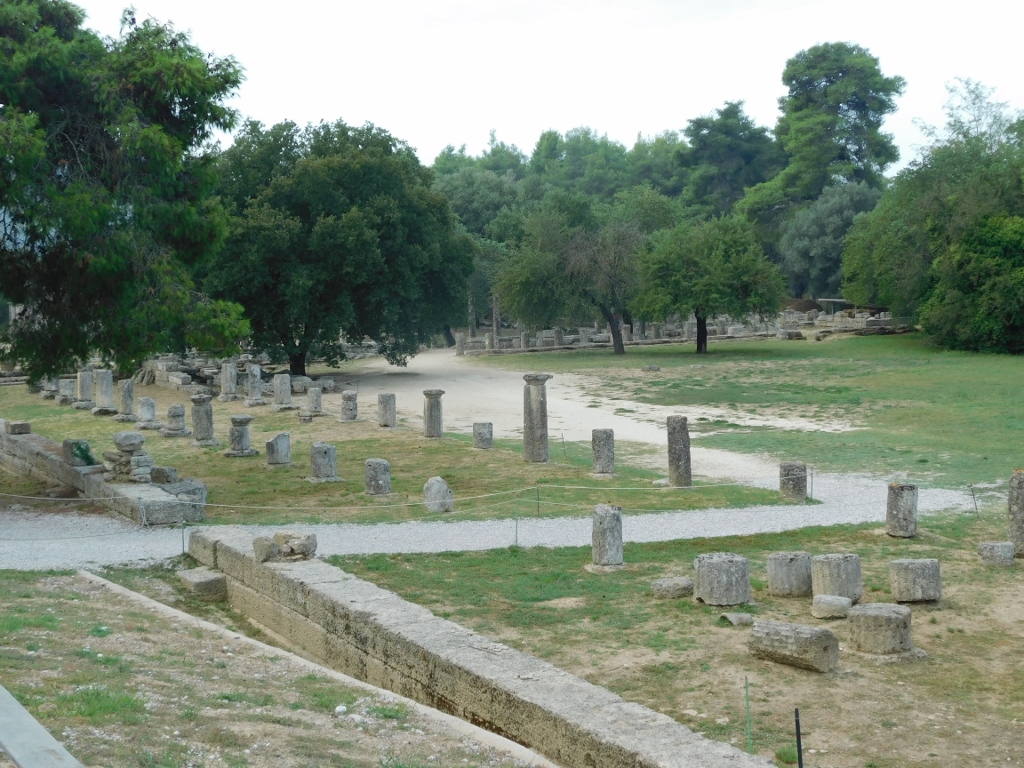 Gymnasium in Olympia
Gymnasium in Olympia
This structure (120x220 meters), with a central courtyard surrounded by a colonnade, was used for the training for running competitions, as well as for javelin and discus throwing.
On the left side, the visitor’s path passes by a few interesting structures. The first one is the Kronion Thermae, or the baths of Kronos, named after Kronion Hill. The first building was erected in the 2nd century BCE, but repairs and expansions continued until the 5th century CE.
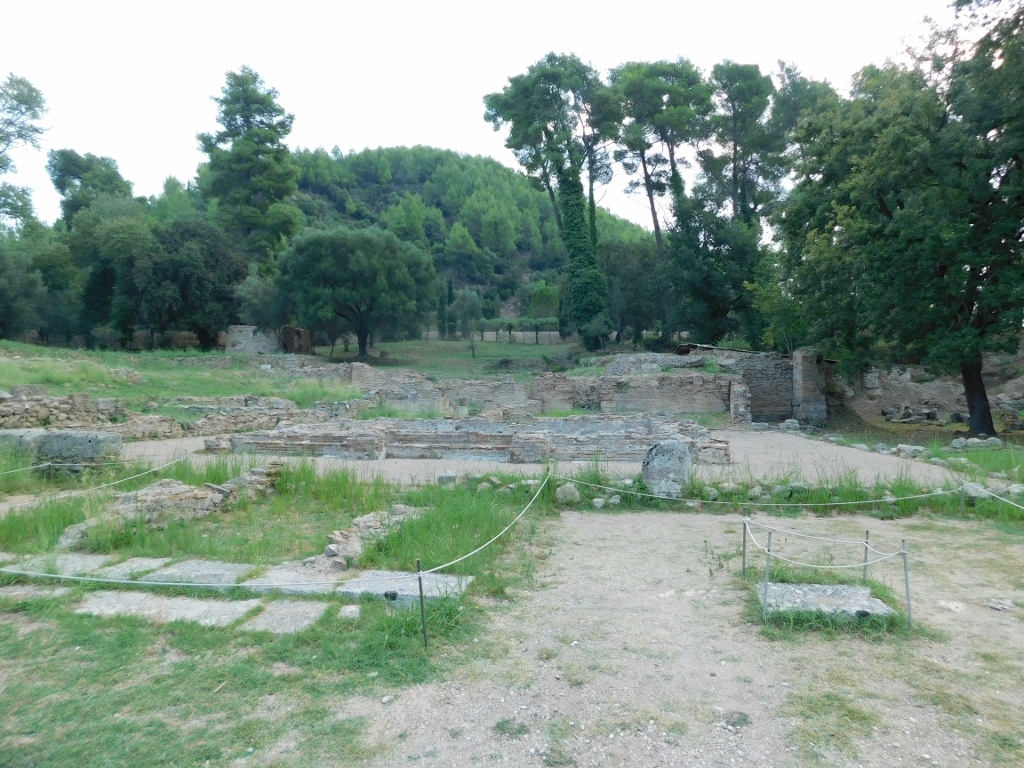 Kronion Thermae in Olympia
Kronion Thermae in Olympia
The next structure to the left from the direction of the entrance, which was already within the Altis, or the sanctuary itself, is the Prytaneion from the 5th century BCE. This was a rectangular building that housed the priests responsible for offering sacrifices at the altars. It also served as a venue for festivities for honoured guests and visitors of the Olympic Games. In addition, this building contained a hearth dedicated to the goddess Hestia (daughter of the titan Kronos, after whom the hill was named, and sister of Zeus), who was the goddess of the domestic hearth, family and home. This flame was considered sacred and eternal, which is why this structure is sometimes referred to as the Sanctuary of the Sacred Flame.
 Prytaneion in Olympia
Prytaneion in Olympia
In continuation there is the Philippeion, which was initiated by Philip II after his victory in a battle in 338 BCE, and completed by his son, Alexander the Great. It is the only structure within the Altis that has a circular plan, surrounded by a colonnade with outer columns of the Ionic order. This was a heroon, a temple specifically celebrating the heroism of the Macedonian dynasty.
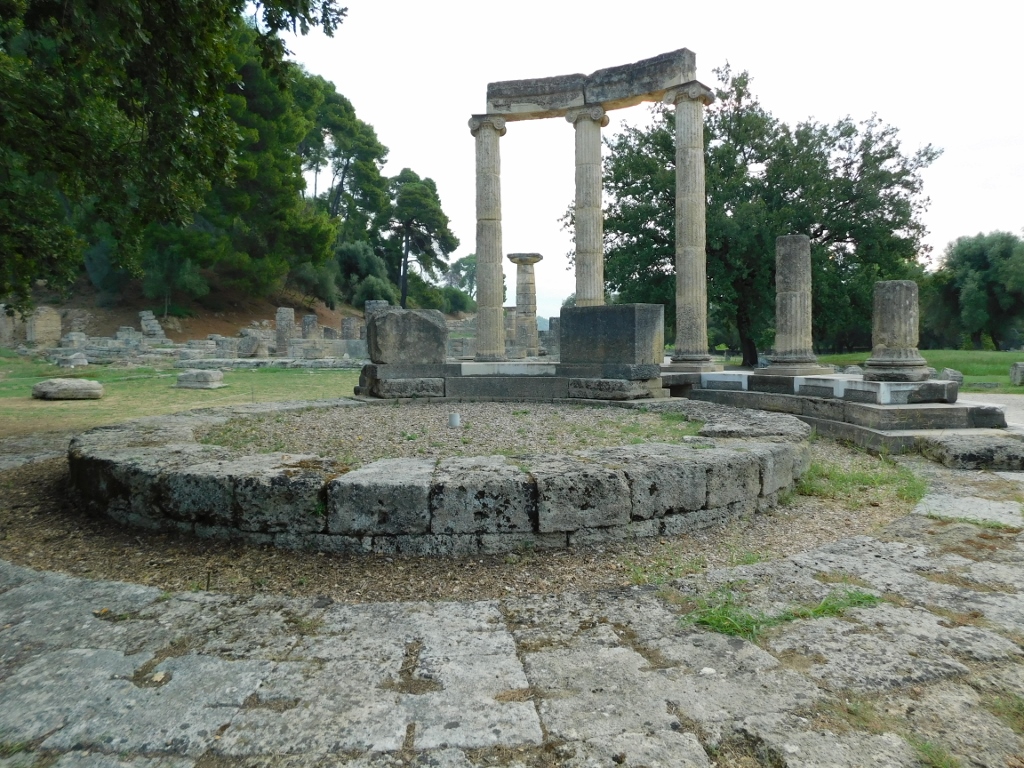 Philippeion in Olympia
Philippeion in Olympia
On the right-hand side of the visitor’s path, formerly outside the walls of the Altis, are the remains of the Palestra from the 3rd century BCE. Due to the growing significance of the Olympic Games, it became necessary to build new structures specifically for the athletes and their needs. The palestras were also used for the training of athletes, but were smaller in size compared to the gymnasiums, serving primarily for wrestling, boxing and jumping practice.
 Palestra in Olympia
Palestra in Olympia
 Palestra in Olympia
Palestra in Olympia
This palestra in Olympia measured 66.35 x 66.75 m, featuring a central courtyard surrounded by a double colonnade. The covered areas were divided and used for undressing, anointing the body with oils, dusting, bathing, and so on. Additionally, this space was used by philosophers, speakers and poets who held their lectures or presented their ideas there.
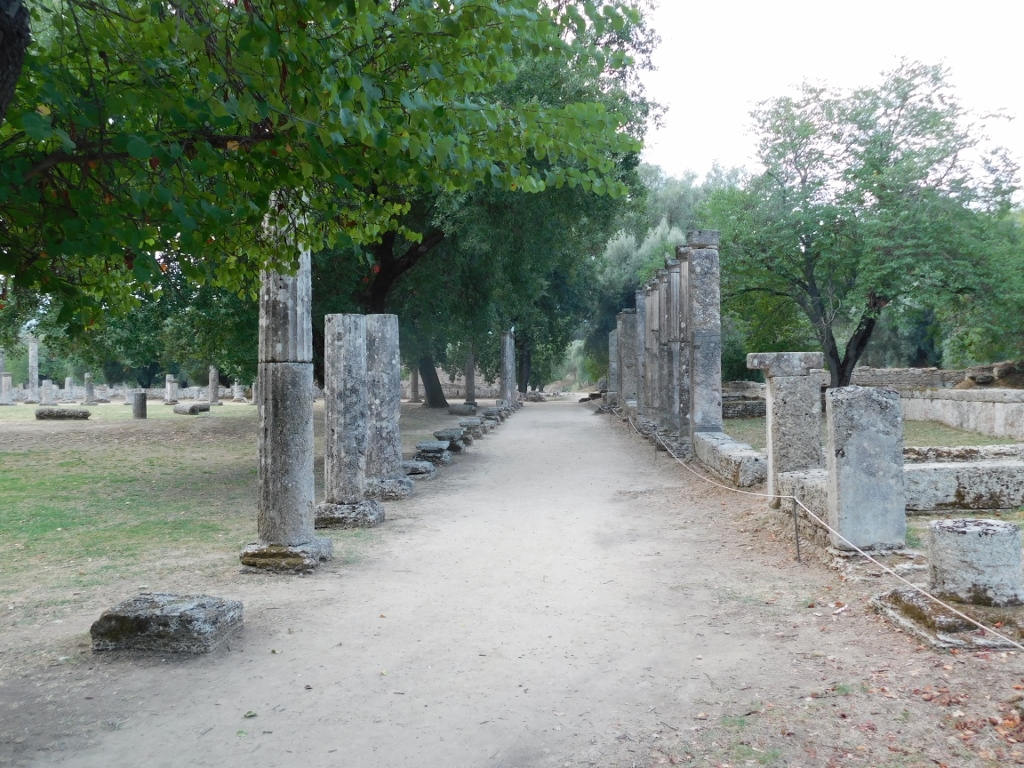 Palestra in Olympia
Palestra in Olympia
After this, I went to the western boundary of the site, where a couple of bath complexes are located. One is the Greek Baths (from the 5th to 1st centuries BCE) and the other is from the Roman period, known as the Kladeos Thermae (from the 2nd to 3rd centuries CE), named after the nearby Kladeos River. Some mosaic-decorated floors have survived to this day, but they were protected during my visit and couldn’t be seen.
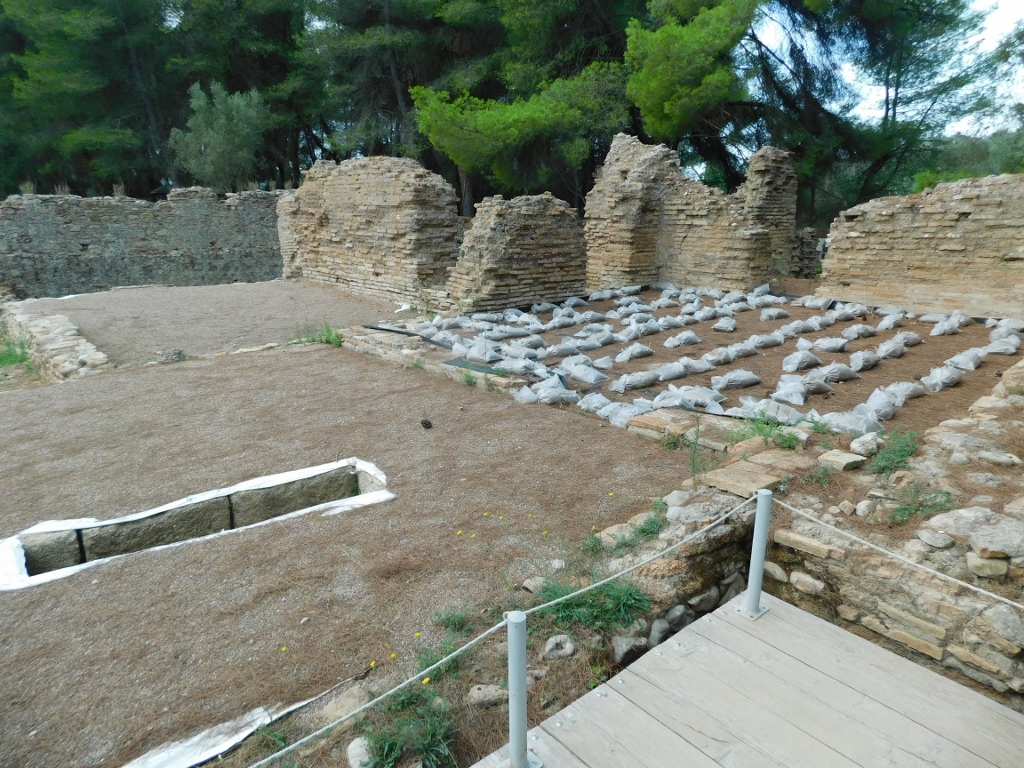 Baths in the western part of the site in Olympia
Baths in the western part of the site in Olympia
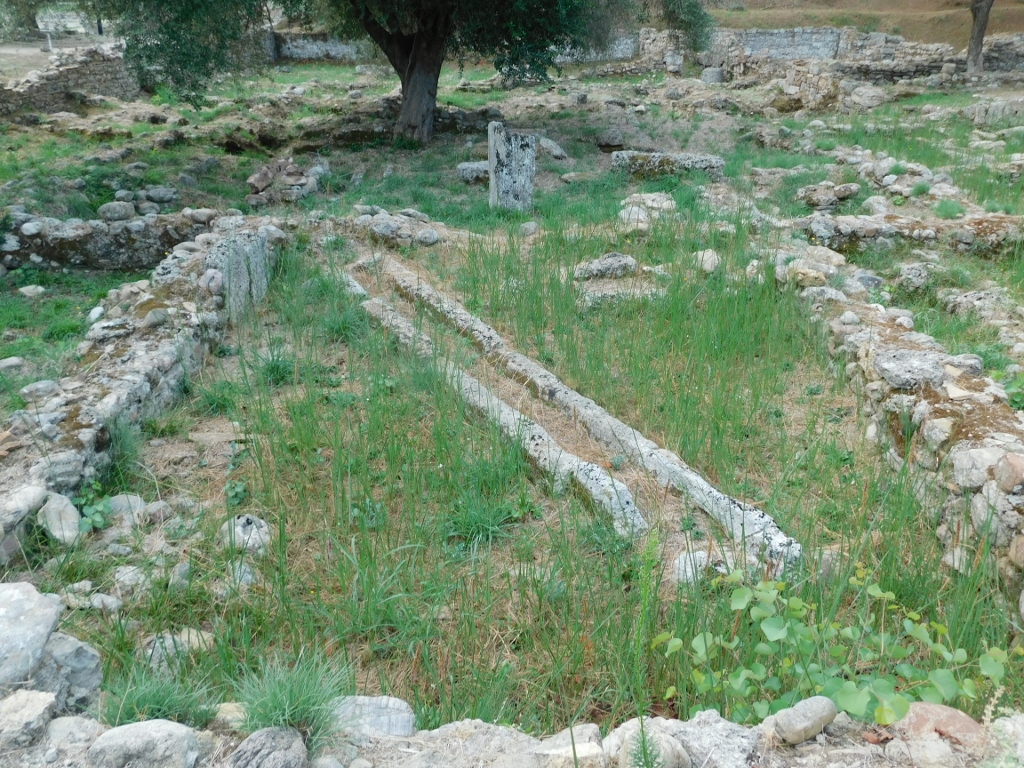 Baths in the western part of the site in Olympia
Baths in the western part of the site in Olympia
In order to reach these baths, I passed by a much more important structure, so now I made my way towards it. This is an early Christian basilica built on the site of the workshop of the famous and probably the most well-known ancient Greek sculptor, Phidias. I had already mentioned him when I wrote about my visit to the Acropolis in Athens in 2022 (see: https://www.svudapodji.com/en/crete-25/).
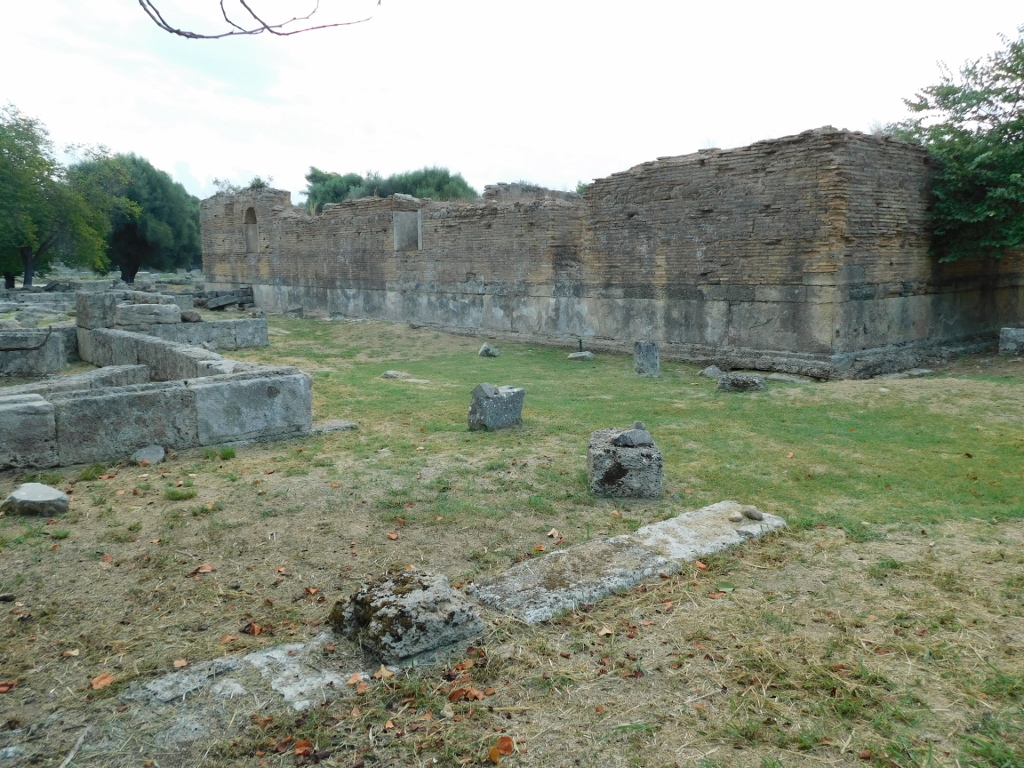 Phidias’s Workshop – Basilica in Olympia
Phidias’s Workshop – Basilica in Olympia
Let me first explain how the basilica came to be here. I have already mentioned the imperial decree from 426 CE issued during the reign of the Roman Emperor Valentinian III, which furthered the persecution of pagans, as Christianity had by then become the official religion of the Roman Empire. In line with this, the Temple of Zeus started to be destroyed and during this period, a basilica was built on the site of Phidias’s workshop, with a Christian community settling in the entire site.
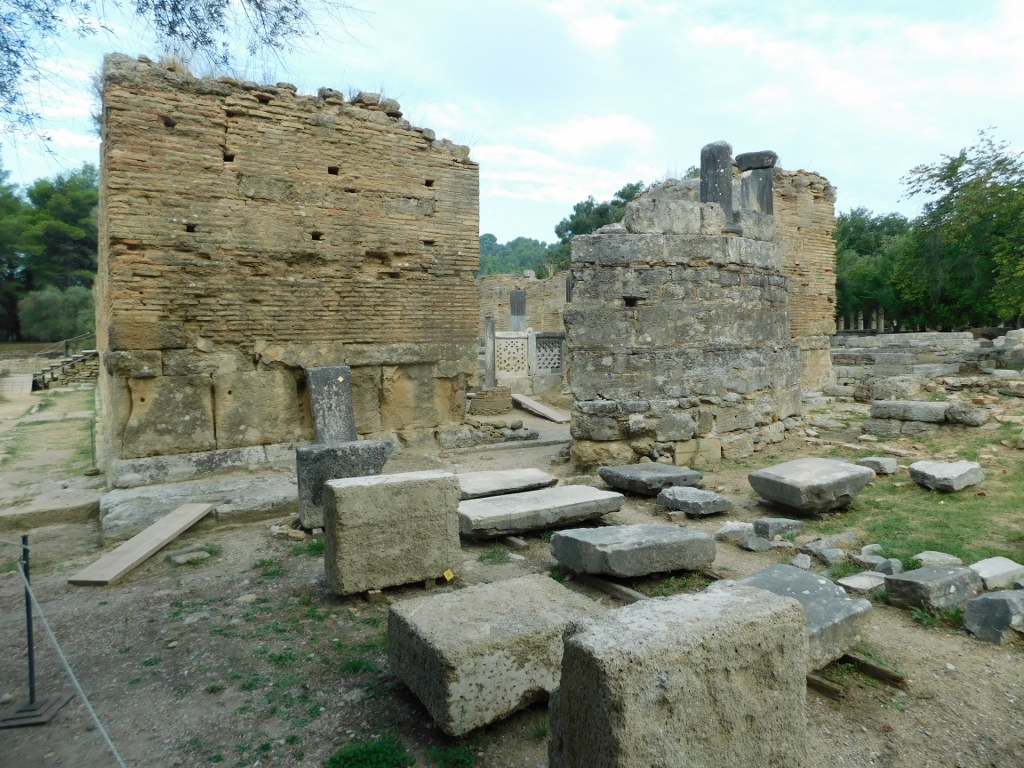 Phidias’s Workshop – Basilica in Olympia
Phidias’s Workshop – Basilica in Olympia
However, the excavations carried out here in the 1950s uncovered, among other things, a cup inscribed with Phidias’s name, which undoubtedly indicates the long-term presence of this artist. Sculpting tools and clay moulds used to create parts for one of Phidias’s most famous works (around 480-430 BCE) were also found. This was the statue of Zeus, which stood in Olympia and was one of the Seven Wonders of the Ancient World.
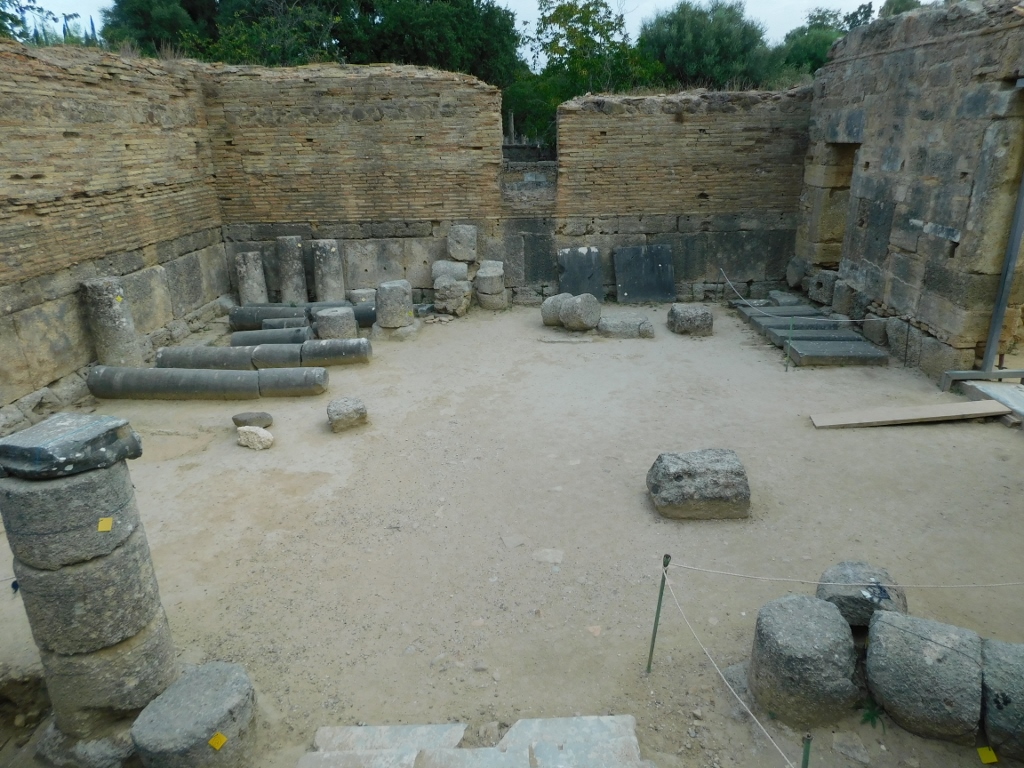 Phidias’s Workshop – Basilica in Olympia
Phidias’s Workshop – Basilica in Olympia
It was a chryselephantine statue created for the temple in Olympia in the early to mid-5th century BCE. The chryselephantine technique means that the sculpture was made with a wooden core covered in ivory and gold. Ivory was used to depict parts of the body, while the clothing was made of gold plates. Very little is known about Zeus’s statue in Olympia, but it is believed that the core of the seated statue was made of ebony and that, in addition to gold, it was adorned with precious stones. It is also thought that the statue stood around 12 to 13 m tall. The fate of the statue and how it ended up is unknown, with only some theories existing about its demise.
 Phidias’s Workshop – Basilica in Olympia
Phidias’s Workshop – Basilica in Olympia
By the way, Phidias used the same technique to create the statue of goddess Athena Parthenos, which stood in the Parthenon on the Athenian Acropolis.
After finishing my visit to Phidias’s Workshop – Basilica in Olympia, I went to look at an interesting wall and the remains of hostels for visitors located in the western part of the site.
 Hostels
Hostels
Then I headed to the nearby and also the largest structure on the site, known as the Leonidaion, which was built around 300 BCE to accommodate important visitors. To start with, I simply walked alongside it.
 Leonidaion in Olympia
Leonidaion in Olympia
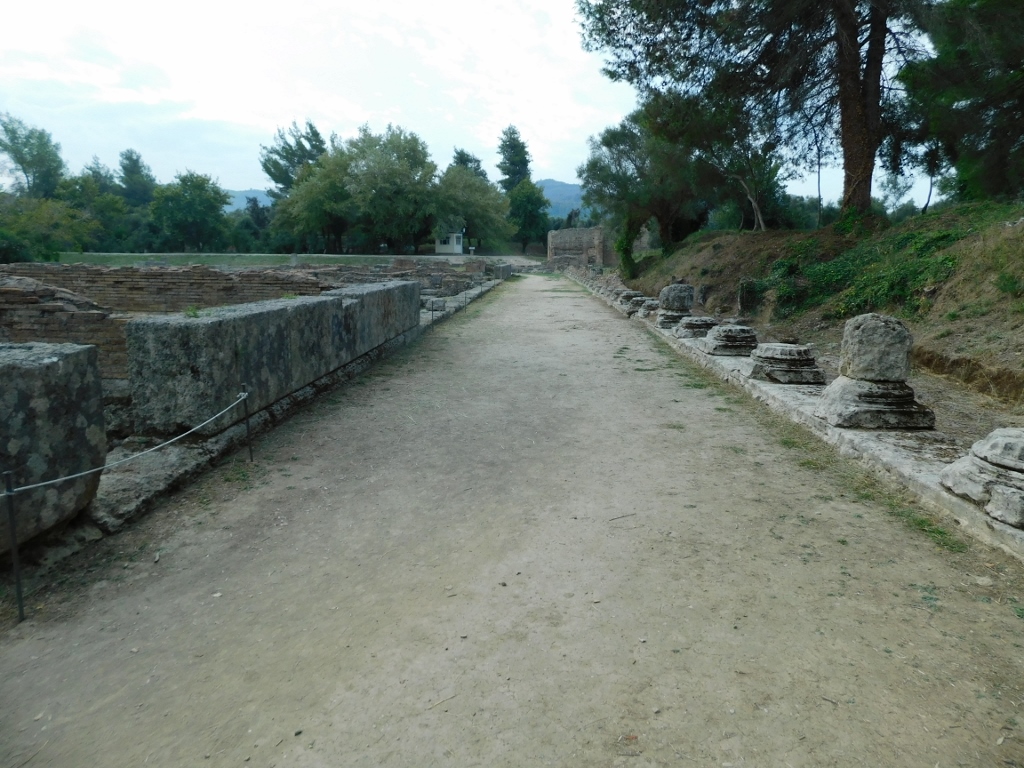 Leonidaion in Olympia
Leonidaion in Olympia
Since I knew I would be exploring around this building, I first took a look at another bathing facility – the Leonidaion Thermae – which were constructed as an addition to the Leonidaion that served as accommodation.
 Leonidaion Thermae in Olympia
Leonidaion Thermae in Olympia
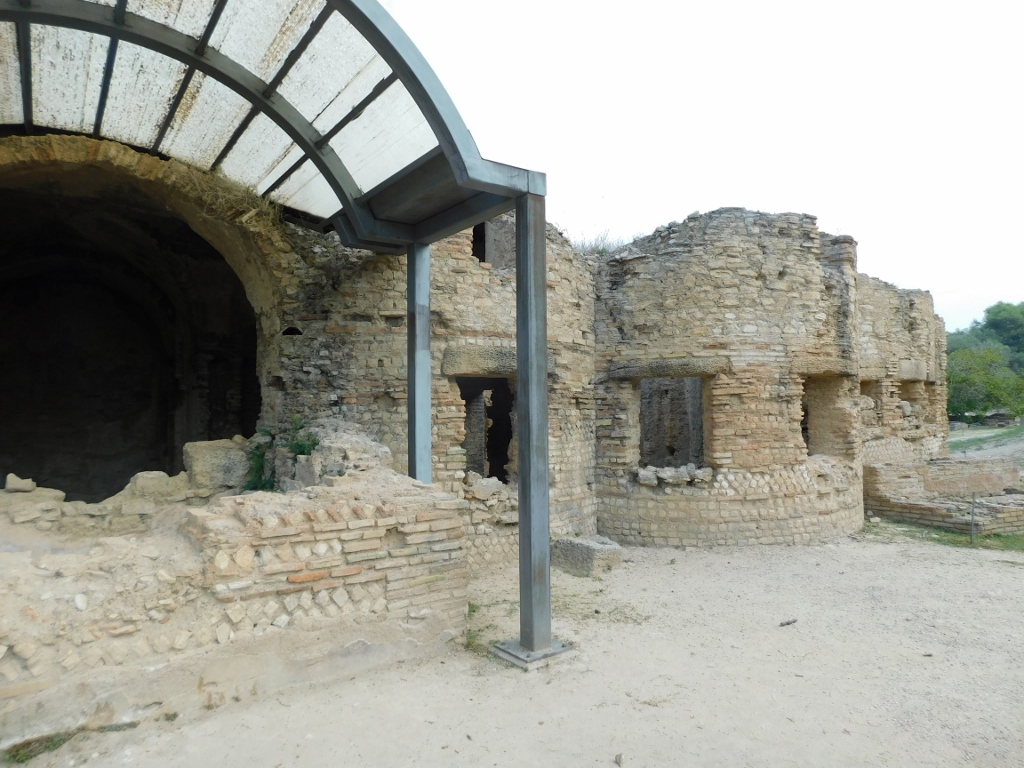 Leonidaion Thermae in Olympia
Leonidaion Thermae in Olympia
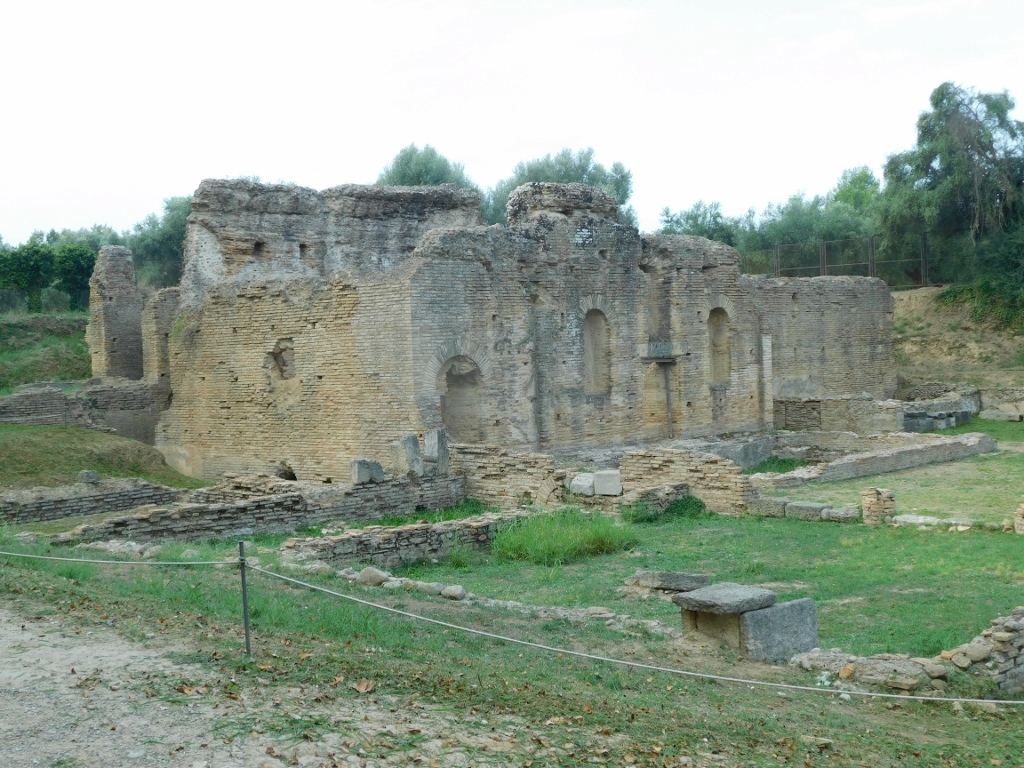 Leonidaion Thermae in Olympia
Leonidaion Thermae in Olympia
As for the Leonidaion itself, its construction in the late 4th century BCE was financed and designed by a certain Leonidas of Naxos, which is where the name of the building comes from. During the Olympic Games, athletes participating in the events stayed here.
 Leonidaion in Olympia
Leonidaion in Olympia
The structure has a rectangular plan (75x81 m) and consisted of four Ionic colonnades with 138 columns that ran along the exterior, as well as a Doric peristyle with 44 columns surrounding the central courtyard. Between these there were the accommodation rooms. During the Roman period, the central courtyard was converted into an open-air swimming pool.
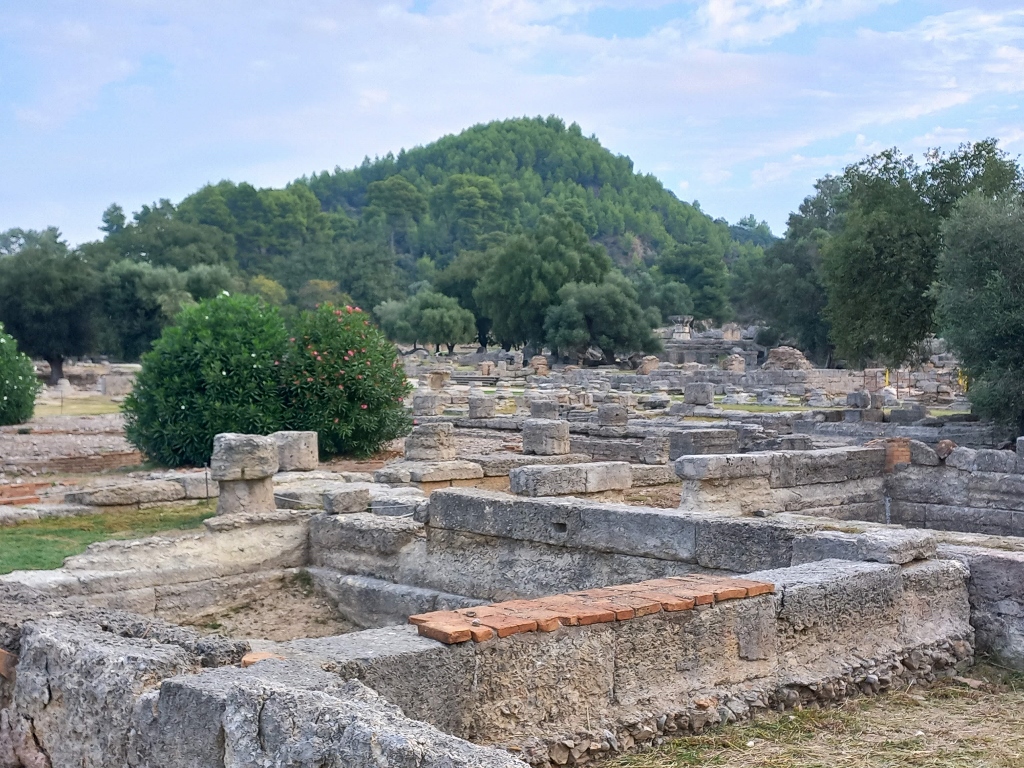 Leonidaion in Olympia
Leonidaion in Olympia
Today, it takes quite a bit of imagination to envision all of this, but the remains of the structure certainly seem intriguing and I enjoyed the lovely view of Kronion Hill. In the next photo, you can also see the remains of the pool in the centre of the building.
 Leonidaion in Olympia
Leonidaion in Olympia
After walking around the Leonidaion, I took another look at it and then I headed towards the main structure on the site, which is the Temple of Zeus.
 Leonidaion in Olympia
Leonidaion in Olympia
 Temple of Zeus in Olympia
Temple of Zeus in Olympia
This Doric temple was constructed between 470 and 457 BCE, with a rectangular plan (64.12 x 27.68 m). It had 13 columns on the longer sides and six on the shorter ones. Inside its sanctuary, the cella, stood the famous seated statue of Zeus, one of the Seven Wonders of the Ancient World. Although the decline and destruction of the temple began during the Christian Roman period, it was ultimately destroyed in two earthquakes – in 522 and 551 CE. Today, only ruins remain of the temple.
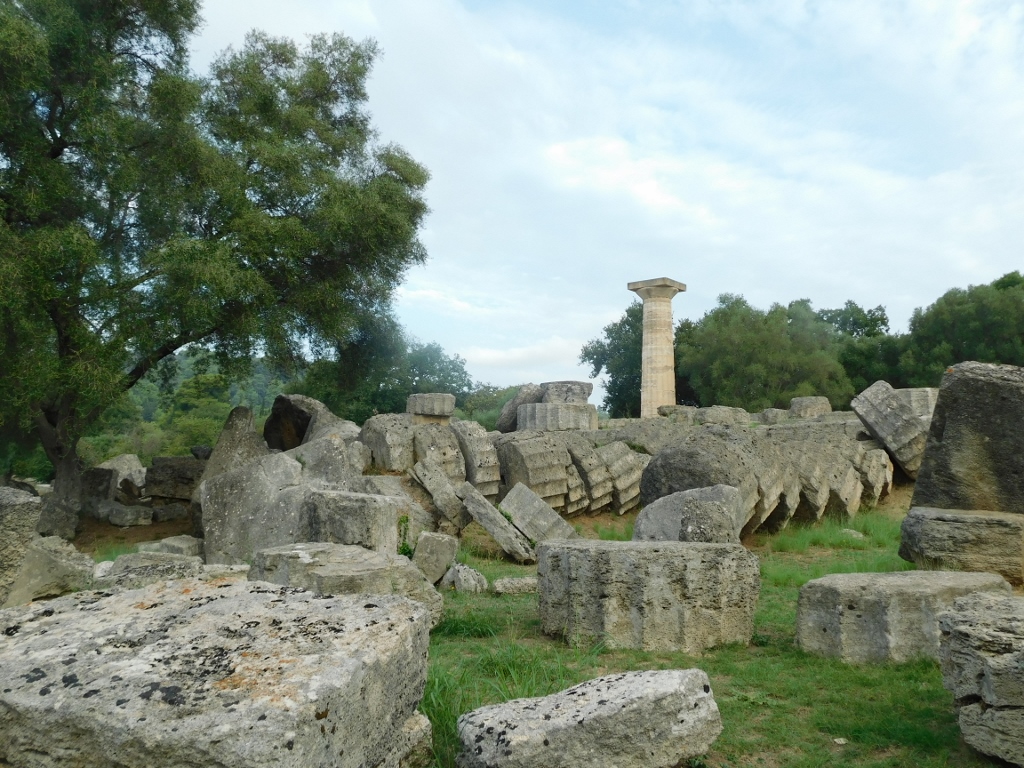 Temple of Zeus in Olympia
Temple of Zeus in Olympia
The only column that still stands upright today was reconstructed as a part of a project for the 2004 Olympics held in Athens.
 Temple of Zeus in Olympia
Temple of Zeus in Olympia
The other parts of the ruins, no matter how picturesque they might appear, mostly just lie scattered around – some in situ, as if they had just collapsed yesterday, while others are neatly arranged for visitors to see them better.
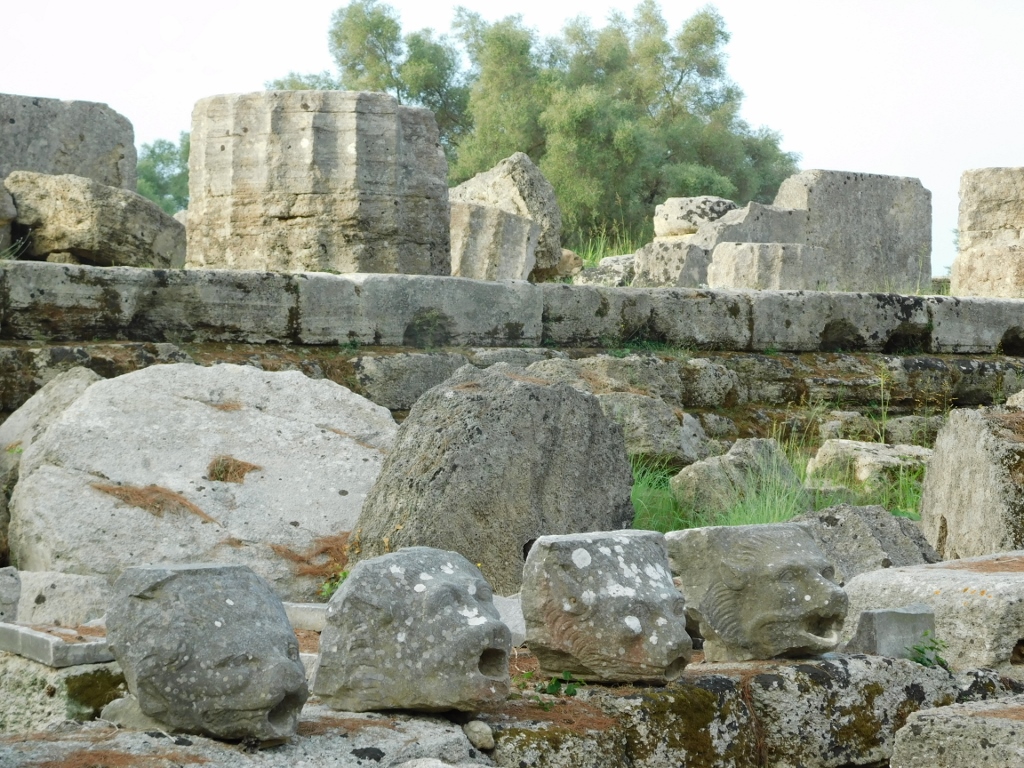 Temple of Zeus in Olympia
Temple of Zeus in Olympia
 Temple of Zeus in Olympia
Temple of Zeus in Olympia
Climbing on the temple is not allowed, just as it wasn't permitted a decade ago when I first visited. Back then, it was January, the low season, and a rainy day, which meant there were hardly any people at the site. I remember a small group of younger visitors from England being led by a local Greek guide. Despite the ropes clearly indicating that climbing the temple was prohibited, this Greek guide, likely hoping for a good tip, allowed group members to climb and even encouraged them. I felt it wasn't my place to say anything, but I thought it was a shame that he wasn’t protecting the monuments of his own culture for the sake of a small profit. Surely the site management didn’t put up those ropes just for the sake of it.
But these are all realities of life and human existence.
As for the site itself, there’s a beautiful view of the northern part of the Altis from the direction of the Temple of Zeus.
 Archaeological Site of Olympia
Archaeological Site of Olympia
In front of the Temple of Zeus once stood a column with a triangular plan that was 9 m tall. Today, its remains are somewhat shorter. However, the most important aspect of that column, which actually served as a sort of pedestal, is that it supported a statue of the goddess Nike, over 2 m high, representing victory. The sculpture of Nike has survived to this day and can be seen in the nearby Archaeological Museum of Olympia. I will share more about it in the next part of my travel stories from the Peloponnese in 2023.
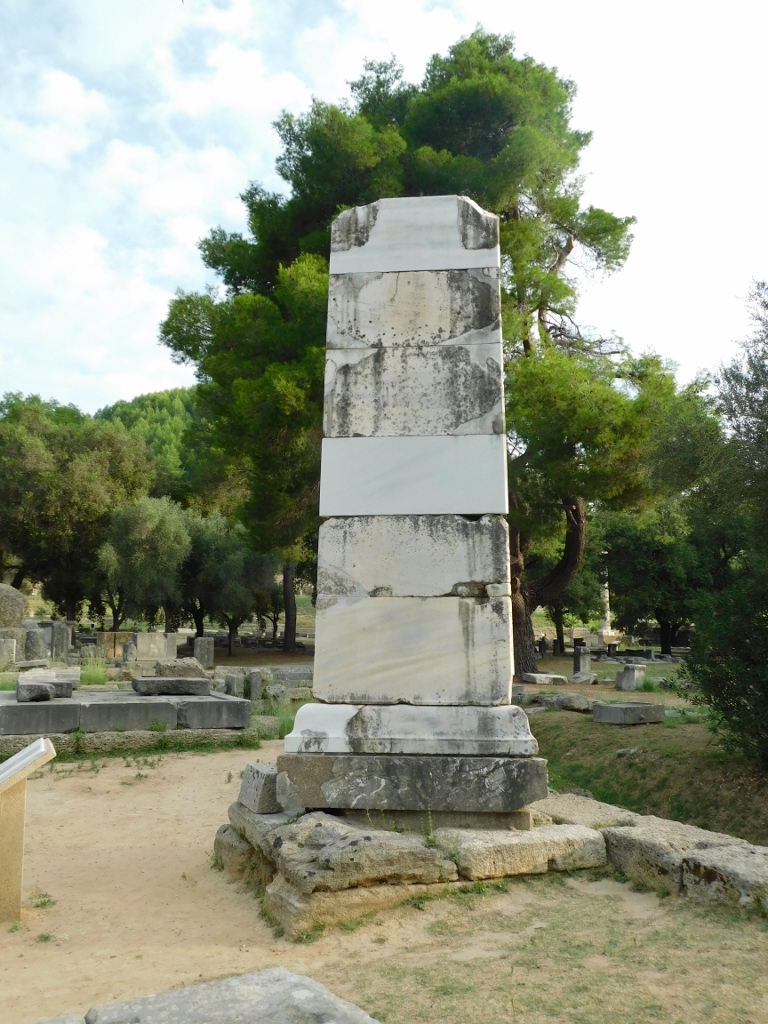 Remains of the votive base in Olympia
Remains of the votive base in Olympia
For now, let me just add that the column and the statue of goddess Nike were funded by the citizens of the Peloponnesian cities of Messenia and Naupactus after their victory over the Spartans in 421 BCE.
Also, here’s a map as a reminder showing where I travelled in September 2023.